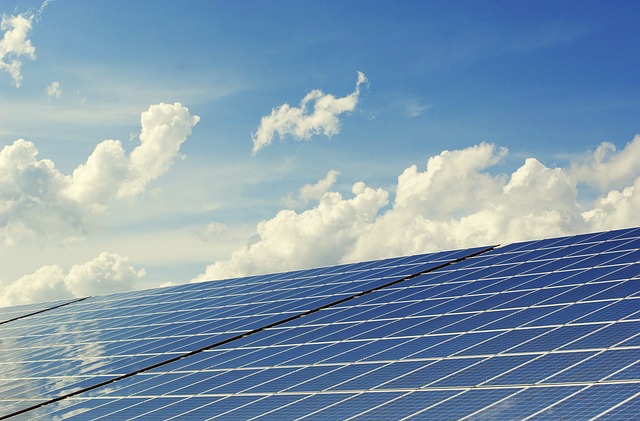Recent advancements in solar energy technology have significantly improved the efficiency and output of photovoltaic systems. Innovations such as bifacial solar panels, which capture sunlight from both sides using reflected and diffused light, have enhanced energy yield, particularly when placed on reflective or albedo surfaces. This design allows for optimized power generation under different lighting conditions. Additionally, transparent solar photovoltaics (TPVs) are enabling the integration of solar energy into buildings without affecting aesthetics, as they allow natural light to pass through while generating electricity. These advancements are making buildings functional in producing solar energy, thus supporting the shift towards sustainable practices. Building-integrated photovoltaics (BIPV) are also gaining popularity by merging solar cells with architectural elements, which maximizes space usage and minimizes visual impact. The integration of advanced tracking systems ensures that solar arrays can follow the sun's movement, significantly increasing energy production. These developments, combined with ongoing research for further efficiency improvements and scalability enhancements, underscore the growing significance of solar energy in a renewable energy-focused future.
Solar energy stands at the forefront of renewable technology, offering a promising pathway to sustainable power generation. This article delves into the cutting-edge advancements in solar technologies that are propelling efficiency to unprecedented levels, ensuring maximum output for a brighter, cleaner energy future. From the innovations in photovoltaic cells to the integration of artificial intelligence, each section explores how these strides are revolutionizing the landscape of solar energy. We will examine the impact of bifacial and transparent solar technologies, the evolution of concentrated solar power systems, and the role of nanotechnology in enhancing performance. Additionally, we’ll discuss the integration of photovoltaics into buildings, the potential of perovskite solar cells, and the importance of material science in developing high-efficiency solutions. The article also addresses cost-effective thin-film solar panels, the benefits of solar tracking systems, and the necessity of recycling for sustainable deployment. With case studies showcasing real-world applications and insights into future trends, this comprehensive guide provides a clear vision of how solar energy technology is evolving to meet the world’s growing demand for clean, efficient power.
- Advancements in Photovoltaic Technology: Maximizing Efficiency in Solar Panels
- The Role of Bifacial and Transparent Solar Technologies in Enhancing Solar Output
Advancements in Photovoltaic Technology: Maximizing Efficiency in Solar Panels

Advancements in photovoltaic technology have been pivotal in enhancing the efficiency of solar panels, a cornerstone of sustainable solar energy generation. Recent breakthroughs in materials science and engineering have led to the development of perovskite solar cells, which promise higher efficiencies and lower production costs compared to traditional silicon-based cells. These innovative cells are not only more efficient at capturing sunlight but also offer greater flexibility, enabling their integration into a variety of surfaces beyond conventional panels. Additionally, bifacial solar panels have emerged as a game-changer; they can absorb light from both sides, increasing their energy yield by approximately 30% under certain conditions. Building-integrated photovoltaics (BIPV) are also gaining traction, seamlessly combining solar cells with building structures to maximize the use of available space and reduce aesthetic impact. Furthermore, advancements in tracking systems allow solar arrays to follow the sun’s movement throughout the day, optimizing their angle to capture the maximum amount of sunlight, thereby significantly enhancing energy output. As these technologies continue to evolve, the potential for solar energy to become an even more dominant and efficient source of clean power becomes increasingly clear. The focus on research and development in this area is likely to lead to new innovations that will further improve the efficiency and scalability of solar energy solutions, solidifying its role as a key component in the global transition towards renewable energy sources.
The Role of Bifacial and Transparent Solar Technologies in Enhancing Solar Output

Solar energy technologies have undergone significant advancements, with bifacial and transparent solar technologies emerging as game-changers in enhancing overall solar output. Bifacial solar panels uniquely capture sunlight from both sides, utilizing reflected and diffused light to generate electricity. This dual-sided functionality increases the total energy yield, especially when installed on reflective surfaces or albedo surfaces like roofs and carports that can bounce additional light onto the panels. The angle of the sun and the characteristics of the underlying surface significantly affect the performance, offering a tailored output based on environmental conditions.
Transparent solar technologies, often referred to as transparent photovoltaics (TPVs), represent another leap forward in solar energy efficiency. These innovative panels are see-through, allowing natural light to pass through while capturing sunlight for conversion into electricity. This makes them ideal for integration into windows and facades of buildings without obstructing views or the aesthetic qualities of the structure. The potential for these technologies to be used in a variety of applications, from residential and commercial buildings to greenhouses and transportation infrastructure, is vast. Their integration into existing and new structures can transform them into power-generating assets, significantly contributing to the expansion of solar energy’s role in our energy mix while maintaining functionality and design integrity. Solar Energy technologies like these not only offer a pathway towards sustainable energy production but also emphasize the importance of innovation in optimizing the capture and conversion of solar irradiance for maximum output.
Solar energy technologies have taken significant strides, with advancements in photovoltaic systems and the integration of bifacial and transparent solar solutions leading the charge for enhanced efficiency and output. As these innovations continue to mature, their potential to power homes, businesses, and communities sustainably is becoming increasingly tangible. The future of renewable energy is bright, with solar technologies poised to play a central role in our transition towards a more sustainable world. Investing in the development and deployment of these high-efficiency solutions is not just an environmental imperative but also a prudent step towards energy security and economic growth. Embracing this clean energy frontier promises a robust and resilient energy landscape for generations to come.
